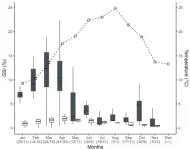(Press-News.org) Ultrasound is one of the most widely used imaging techniques in medicine, but up until recently it hardly played a role in imaging the tiniest structures of our bodies such as cells. “Clinical ultrasound, like the kind used for pregnancy scans, creates real-time images of body parts”, first author Baptiste Heiles explains. “It allows diagnosis of various diseases, or to monitor a developing baby. However, what is going on at a microscopic level remains hidden.”
Imaging living cells in 3D
Now, a team of scientists from TU Delft, the Netherlands Institute for Neuroscience and Caltech managed to image specifically labelled cells in 3D with ultrasound. For the first time, they imaged living cells inside whole organs across volumes the size of a sugar cube. In comparison, current light-based microscopes often require imaging of non-living samples, Heiles says. “The sample or organ of interest has to be removed and processed, and you lose the ability to track activity of cells over time”.
Artist’s impression of the new ultrasound technique, called nonlinear sound sheet microscopy. The blue lines represent two ultrasound waves intersecting in an X-shape pattern to scan cells and capillaries in body tissue. The cells and capillary vessels are labelled with ultrasound probes (in cyan and pink), making them light up in ultrasound images. (Credits: Maayan Harel, Maresca Lab)
The present leading technology to image how living cells behave in 3D, for example during the development of embryos, is called light sheet microscopy. This method is limited to translucent or thin specimens because light cannot penetrate deeper than 1 mm in opaque tissue. “Ultrasound can image centimetres deep in opaque mammal tissue, allowing non-invasive imaging of whole organs. This gives us information about how cells behave in their natural environment, something that light-based methods can’t do in larger, living tissues”, lead researcher David Maresca says.
Labelling capillaries and cells with sound-reflecting probes
Key to this innovation in ultrasound imaging—a method called Nonlinear sound sheet microscopy—was the discovery of a sound-reflecting probe made in the Shapiro Lab at Caltech. Heiles: “This probe is a nanoscale gas-filled vesicle that lights up in ultrasound images, making cells visible. These vesicles have a protein shell and we can engineer them to tune their brightness in images. We used these gas vesicles to track cancer cells.”
Brain imaging
In addition to revealing cells, the team used ultrasound and microbubbles as probes circulating in the blood stream to detect brain capillaries. Heiles: “To our knowledge, nonlinear sound sheet microscopy is the first technique capable of observing capillaries in living brains. This breakthrough has tremendous potential to diagnose small vessel diseases in patients.” Since microbubble probes are already approved for human use, this technique could be deployed in hospitals in a few years.
Potential for cancer research
Beyond clinical practice, sound-sheet microscopy can greatly benefit biological research and the development of new cancer treatments in particular, according to Maresca. “Our imaging technique can distinguish healthy versus cancer tissue. Furthermore, it can visualise the necrotic core of a tumour; the centre of the tumour where cells start dying due to a lack of oxygen. Thus, it could assist in monitoring the progression of cancer and the response to treatment.”
END
Revealing capillaries and cells in living organs with ultrasound
2025-04-03
ELSE PRESS RELEASES FROM THIS DATE:
American College of Physicians awards $260,000 in grants to address equity challenges in obesity care
2025-04-03
PHILADELPHIA, April 3, 2025 – Today, the American College of Physicians (ACP) announced that it has awarded a total of $260,000 in grants to support regional programs that address equity challenges in obesity care. Thirteen grantees were each awarded $20,000 to implement collaborative regional outreach projects.
Through “Advancing Equitable Obesity Care through Regional Action Grants,” ACP aims to inspire local collaboration models across the country to train and empower medical professionals to partner with patients to combat misinformation and heighten clinical capacity to manage care for people with obesity. The program capitalizes ...
Researchers from MARE ULisboa discover that the European catfish, an invasive species in Portugal, has a prolonged breeding season, enhancing its invasive potential
2025-04-03
The European Catfish is the largest freshwater fish in Europe, reaching up to 2.8 meters in length and 130 kg in weight. It was first detected in Portugal in 2014. As a top predator, it has no natural enemies and exhibits high fecundity, with females capable of producing up to half a million oocytes (unfertilized eggs). “This is not new information, as this invasive species reaches large sizes, and there is a direct relationship between abdominal cavity volume and the total number of oocytes produced,” said Christos Gkenas, a researcher at MARE-ULisboa and the study’s lead author. ...
Rakesh K. Jain, PhD, FAACR, honored with the 2025 AACR Award for Lifetime Achievement in Cancer Research
2025-04-03
CHICAGO – The 2025 AACR Award for Lifetime Achievement in Cancer Research will be presented to Rakesh K. Jain, PhD, Fellow of the AACR Academy, during the AACR Annual Meeting 2025, to be held April 25-30 at the McCormick Place Convention Center in Chicago, Illinois.
Jain is the director of the Edwin L. Steele Laboratories for Tumor Biology in the Department of Radiation Oncology at Massachusetts General Hospital and the Andrew Werk Cook Professor of Radiation Oncology (Tumor Biology) at Harvard ...
Solar cells made of moon dust could power future space exploration
2025-04-03
The same dirt that clings to astronauts’ boots may one day keep their lights on. In a study publishing April 3 in the Cell Press journal Device, researchers created solar cells made out of simulated Moon dust. The cells convert sunlight into energy efficiently, withstand radiation damage, and mitigate the need for transporting heavy materials into space, offering a potential solution to one of space exploration's biggest challenges: reliable energy sources.
“The solar cells used in space now ...
Deporting immigrants may further shrink the health care workforce
2025-04-03
About The Study: More than 1 million noncitizen immigrants (one-third of them undocumented) work in health care in the U.S. Their ranks include skilled personnel who would be difficult to replace, especially if legal immigration is further restricted. Many health care workers may be removed if President Trump implements plans to deport undocumented immigrants and those losing temporary protected status (e.g., from Haiti and Venezuela).
Corresponding Author: To contact the corresponding author, Lenore S. Azaroff, MD, ScD, email Lenore_Azaroff@yahoo.com.
To ...
Border region emergency medical services in migrant emergency care
2025-04-03
About The Study: The findings of this qualitative study of emergency medical services (EMS) clinicians suggest that migration has a complex, multidimensional influence on EMS clinicians in the border region. Deterrence-focused actions have not decreased the number of crossings but rather pushed migrants to cross in more dangerous ways, leading to more injuries and deaths. The findings suggest that the strain placed on local EMS clinicians is unsustainable and may be exacerbated by increased deterrence-based policies. Instead, border-region EMS clinicians need increased federal funding to support their work.
Corresponding Author: To contact the corresponding ...
Resident physician intentions regarding unionization
2025-04-03
About The Study: In this survey study, most resident physicians reported either being in a union or supporting unionization at their institution, citing pay and financial security as critical factors in their consideration of unionization. Future research should investigate other factors and whether unionization achieves its goals of increased pay and benefits, work hours, and well-being.
Corresponding Author: To contact the corresponding author, Laura K. Barger, PhD, email lkbarger@hms.harvard.edu.
To access the embargoed study: Visit our For The Media ...
Healthy nutrition and physical lifestyle choices lower cancer mortality risk for survivors, new ACS study finds
2025-04-03
In 2022, the American Cancer Society (ACS) updated its nutrition and activity guidelines for cancer survivors, recommending they avoid obesity, stay physically active, eat a healthy diet, and limit alcohol intake. New research by ACS scientists shows a lifestyle aligned with these guidelines is associated with a lower mortality risk among non-smoking survivors of obesity-related cancers in the United States. Survivors who maintained a healthy lifestyle both before and after their diagnosis — or those who improved their habits after diagnosis — also had a lower mortality risk. The study is out today in the Journal of the National ...
Mass General Brigham researchers reveal 17 modifiable risk factors shared by stroke, dementia, and late-life depression
2025-04-03
Age-related brain diseases such as stroke, dementia, and late-life depression are a debilitating part of growing older, but people can lower their risk of these diseases through behavioral and lifestyle changes. In a new extensive systematic review, Mass General Brigham researchers identified 17 modifiable risk factors that are shared by stroke, dementia, and late-life depression. Modifying any one of them can reduce your risk of all three conditions. The findings, which provide evidence to inform novel tools, such as the Brain Care Score, are ...
Promising drug discovery research gets funding boost from Ontario Institute for Cancer Research
2025-04-03
April 3, 2025, ONTARIO – The Ontario Institute for Cancer Research (OICR) has announced its support for five Ontario research teams working to develop the next generation of medicines that kill tumours more effectively, cause fewer side effects and reduce the risk that cancer will come back.
The projects will be funded as part of OICR’s Cancer Therapeutics Innovation Pipeline (CTIP) awards, which provides research teams with up to $300,000 over two years to help advance promising drug discovery research so that new cancer drugs can more quickly and safely reach patients.
“Ontario ...

